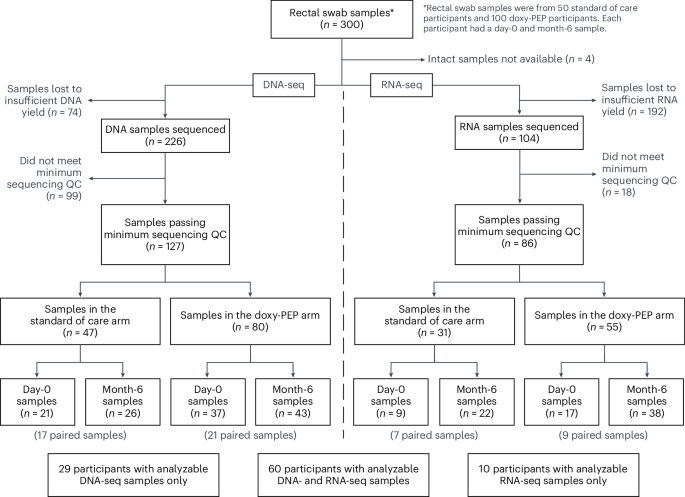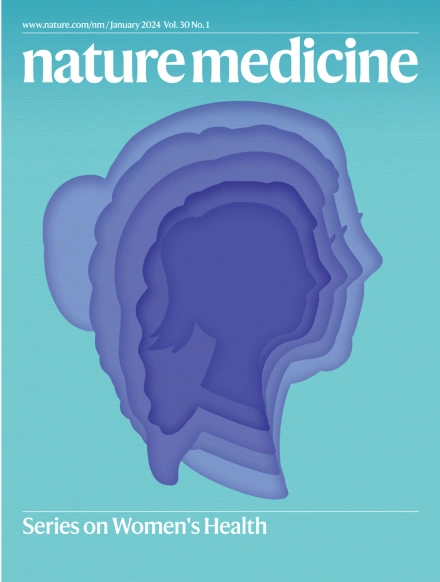多西环素性传播感染暴露后预防疗法对肠道微生物组和抗菌药耐药性组的影响
IF 58.7
1区 医学
Q1 BIOCHEMISTRY & MOLECULAR BIOLOGY
引用次数: 0
摘要
强力霉素暴露后预防疗法(doxy-PEP)可减少男男性行为者和变性女性的细菌性传播感染。尽管强力霉素预防疗法已准备好在临床上广泛使用,但它对抗菌药耐药性的影响仍是人们关注的首要问题,因为它对肠道微生物组和耐药性组(或肠道微生物组中存在的抗菌药耐药性基因 (ARGs) 的影响尚不清楚。为了研究这些影响,我们对 DoxyPEP 试验的参与者进行了研究,该试验是一项随机临床试验,在男男性行为者和变性女性中比较使用强力霉素-PEP(无套性行为后一次性服用 200 毫克强力霉素)(DP 组,n = 100)和标准护理(SOC 组,n = 50)。我们对入组(0 天)和 6 个月后(6 个月)自取的直肠拭子进行了元基因组 DNA 测序(DNA-seq)或元转录组 RNA 测序(RNA-seq)。DNA-seq数据可对89名参与者的127个样本进行分析,RNA-seq数据可对70名参与者的86个样本进行分析。我们比较了两个研究臂之间以及不同时间段的细菌微生物组和抗药性组。有DNA-seq数据的参与者自入院以来服用强力霉素剂量的中位数为:SOC研究组为0(四分位距(IQR):0-7次),DP研究组为42(IQR:27-64次)。在所有的第 0 天 DNA-seq 样本和 85% 的第 0 天 RNA-seq 样本中都检测到了四环素 ARGs。从第 0 天到第 6 个月,DP 组参与者抗原组中的四环素 ARGs 比例质量从元基因组的 46% 增加到 51%(P = 2.3 × 10-2),元转录组从 4% 增加到 15%(P = 4.5 × 10-6),但未观察到其他 ARG 类别有统计学意义的显著增加。接触更多剂量的强力霉素与四环素 ARGs 在元基因组(Spearman's ρ = 0.23,P = 9.0 × 10-3)和元转录组(Spearman's ρ = 0.55,P = 3.7 × 10-8)中的富集比例相关。通过DNA-seq或RNA-seq评估,DP参与者第0天和第6个月样本的细菌微生物组α多样性、β多样性和细菌总数均无差异。在基于丰度的相关性分析中,我们观察到四环素 ARGs 与特定细菌类群(包括一些常见的人类病原体)之间的相关性随着时间的推移而增强。总之,在 6 个月的时间内使用多西环戊二烯治疗方案与肠道抗药性组中四环素 ARGs 比例的增加和四环素 ARGs 表达的增加有关。使用多西环戊二烯治疗方案 6 个月后,在肠道微生物组的α和β多样性或分类组成方面没有观察到残余差异。随着强力霉素-PEP作为一项公共卫生策略的实施,需要对强力霉素耐药病原体进行进一步的研究和人群监测,以了解这些发现的意义。ClinicalTrials.gov 注册号:NCT03980223:NCT03980223。本文章由计算机程序翻译,如有差异,请以英文原文为准。


Impact of doxycycline post-exposure prophylaxis for sexually transmitted infections on the gut microbiome and antimicrobial resistome
Doxycycline post-exposure prophylaxis (doxy-PEP) reduces bacterial sexually transmitted infections among men who have sex with men and transgender women. Although poised for widespread clinical implementation, the impact of doxy-PEP on antimicrobial resistance remains a primary concern as its effects on the gut microbiome and resistome, or the antimicrobial resistance genes (ARGs) present in the gut microbiome, are unknown. To investigate these effects, we studied participants from the DoxyPEP trial, a randomized clinical trial comparing doxy-PEP use, a one-time doxycycline 200-mg dose taken after condomless sex (DP arm, n = 100), to standard of care (SOC arm, n = 50) among men who have sex with men and transgender women. From self-collected rectal swabs at enrollment (day-0) and after 6 months (month-6), we performed metagenomic DNA sequencing (DNA-seq) or metatranscriptomic RNA sequencing (RNA-seq). DNA-seq data were analyzable from 127 samples derived from 89 participants, and RNA-seq data were analyzable from 86 samples derived from 70 participants. We compared the bacterial microbiome and resistome between the two study arms and over time. The median number of doxycycline doses taken since enrollment by participants with DNA-seq data was zero (interquartile range (IQR): 0–7 doses) for the SOC arm and 42 (IQR: 27–64 doses) for the DP arm. Tetracycline ARGs were detected in all day-0 DNA-seq samples and in 85% of day-0 RNA-seq samples. The proportional mass of tetracycline ARGs in the resistome increased between day-0 and month-6 in DP participants from 46% to 51% in the metagenome (P = 2.3 × 10−2) and from 4% to 15% in the metatranscriptome (P = 4.5 × 10−6), but no statistically significant increases in other ARG classes were observed. Exposure to a higher number of doxycycline doses correlated with proportional enrichment of tetracycline ARGs in the metagenome (Spearman’s ρ = 0.23, P = 9.0 × 10−3) and metatranscriptome (Spearman’s ρ = 0.55, P = 3.7 × 10−8). Bacterial microbiome alpha diversity, beta diversity and total bacterial mass did not differ between day-0 and month-6 samples from DP participants when assessed by either DNA-seq or RNA-seq. In an abundance-based correlation analysis, we observed an increase over time in the strength of the correlation between tetracycline ARGs and specific bacterial taxa, including some common human pathogens. In sum, doxy-PEP use over a 6-month period was associated with an increase in the proportion of tetracycline ARGs comprising the gut resistome and an increase in the expression of tetracycline ARGs. At 6 months of doxy-PEP use, no residual differences were observed in alpha and beta diversity or taxonomic composition of the gut microbiome. As doxy-PEP is implemented as a public health strategy, further studies and population-level surveillance of doxycycline-resistant pathogens are needed to understand the implications of these findings. ClinicalTrials.gov registration number: NCT03980223 . In participants from a randomized controlled trial, doxy-PEP use over 6 months minimally affected the gut microbiome’s taxonomic composition but increased the abundance and active expression of tetracycline antibiotic resistance genes.
求助全文
通过发布文献求助,成功后即可免费获取论文全文。
去求助
来源期刊

Nature Medicine
医学-生化与分子生物学
CiteScore
100.90
自引率
0.70%
发文量
525
审稿时长
1 months
期刊介绍:
Nature Medicine is a monthly journal publishing original peer-reviewed research in all areas of medicine. The publication focuses on originality, timeliness, interdisciplinary interest, and the impact on improving human health. In addition to research articles, Nature Medicine also publishes commissioned content such as News, Reviews, and Perspectives. This content aims to provide context for the latest advances in translational and clinical research, reaching a wide audience of M.D. and Ph.D. readers. All editorial decisions for the journal are made by a team of full-time professional editors.
Nature Medicine consider all types of clinical research, including:
-Case-reports and small case series
-Clinical trials, whether phase 1, 2, 3 or 4
-Observational studies
-Meta-analyses
-Biomarker studies
-Public and global health studies
Nature Medicine is also committed to facilitating communication between translational and clinical researchers. As such, we consider “hybrid” studies with preclinical and translational findings reported alongside data from clinical studies.
 求助内容:
求助内容: 应助结果提醒方式:
应助结果提醒方式:


